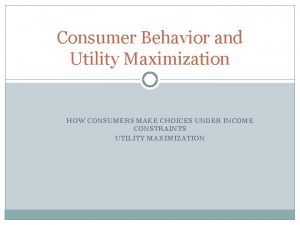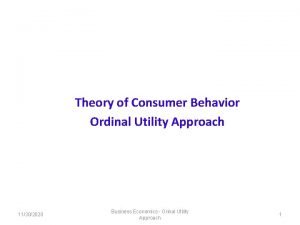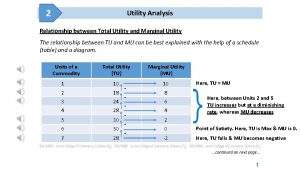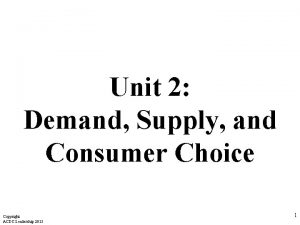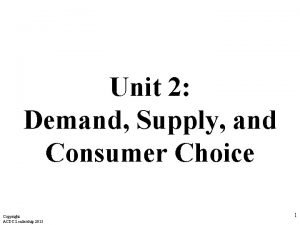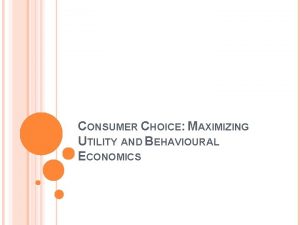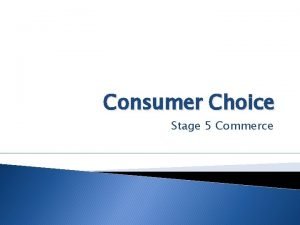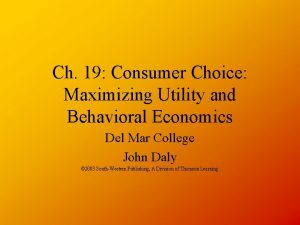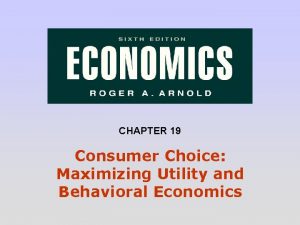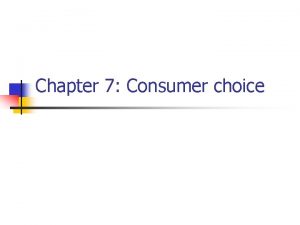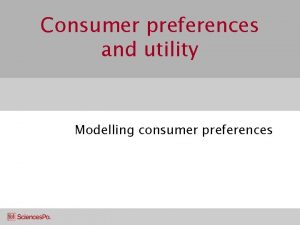Consumer Choice Maximizing Utility Ch 18 R A








- Slides: 8

Consumer Choice: Maximizing Utility Ch. 18, R. A. Arnold, Economics 9 th Ed

Utility Theory In this chapter we study the household (or consumer) using a model called the Utility Theory Remember: Households consume goods (e. g. food, education) since it gives them utility (satisfaction or benefit or happiness) Assumption: The aim of households is to maximize utility i. e. They want to obtain the highest amount of utility from their limited income Utils: The unit of utility. It is used to measure utility. E. g. If drinking a cup of tea gives you 10 utils and drinking a cup of coffee gives you 8 utils. It means you get more satisfaction (utility) from tea as compared to coffee.

Marginal Utility and Total Utility Marginal Utility (MU): The (additional or extra) utility obtained from one additional (extra) unit of a good. E. g. the marginal utility of the 1 st cup of tea can be 10 utils. The marginal utility of the 2 nd cup is 8 utils. And 3 rd cup is 5 utils. Total utility from 3 cups = 10 + 8 + 5 = 23 utils When we say households want to maximize utility we mean they want to maximize the total utility (i. e. obtain the highest amount of utils)

Law of Diminishing Marginal Utility The marginal utility (MU) gained by consuming equal successive units of a good will decline as the amount consumed (Q) increases during a given period of time. In symbols: if Q ↑ then MU ↓ (if Q ↓ then MU ↑ ), ceteris paribus This law simply tells that the first cup of tea gives us more satisfaction than the second one. The MU 1 st cup = 10 , MU 2 nd cup = 8 & MU 3 rd cup = 5. i. e. we get bored of consuming the same product

Consumer Equilibrium: Maximizing Utility Here, we analyse how a household (consumer) maximizes utility Constraint of household: limited (fixed) income (budget) We are assuming that the household is consuming all of their income on 10 apples and 10 oranges per week. The price (P) of each apple = $1 and the price (P) of each orange = $1. (What is the households total income per week? ) Also given, MU oranges = 30 utils and MU apples = 20 utils i. e. the utility obtained from the 10 th apple is 20 utils and 10 th orange is 30 utils

**According to Economic theory consumers make purchasing decisions by comparing the marginal utility per dollar from different goods (MU ÷ P)** Here we can see, (MU orange ÷ P orange ) > (MU apple ÷ P apple) This means the household can get more marginal utility per dollar from oranges as compared to apples. So the household buys more oranges to increase their total utility. But since they are consuming all of their limited income, they have to reduce the consumption of apples, to buy more oranges.

Continued If the household buys more oranges then we know the MU from oranges will fall (Law of Diminishing Marginal Utility). Here when the household buys 1 more orange, MU from orange falls to 25 utils. And as they buy 1 less apple, MU from apples increases to 25 utils. Now, (MU orange ÷ P orange ) = (MU apple ÷ P apple). At this point, the household is maximizing its utility and they have no further incentive to change their consumption (they are in equilibrium). At equilibrium they are consuming 11 oranges and 9 apples.

Another Perspective We may look at the last example from another angle: Using the income of $20, the household can buy various combinations of apples (A) and oranges (O). E. g. they can buy (15 A , 5 O) or (5 A, 15 O) or (10 A, 10 O)…and (9 A, 11 O). Out of all these choices (combinations), the (9 A, 11 O) combination gives the household maximum utility (satisfaction). Can you relate it to reality? E. g. a family in Dhaka purchases 5 kg rice, 1 dozen eggs every week. Why? Because it gives them the maximum utility (satisfaction) from their given income.
 All about food chains
All about food chains Utility maximizing rule example
Utility maximizing rule example Consumer equilibrium under cardinal utility approach
Consumer equilibrium under cardinal utility approach Relation between marginal utility and total utility
Relation between marginal utility and total utility Indiana office of utility consumer counselor
Indiana office of utility consumer counselor Good choice or bad choice
Good choice or bad choice Unit 2 demand supply and consumer choice
Unit 2 demand supply and consumer choice Unit 2 demand supply and consumer choice answer key
Unit 2 demand supply and consumer choice answer key Utility maximization
Utility maximization

